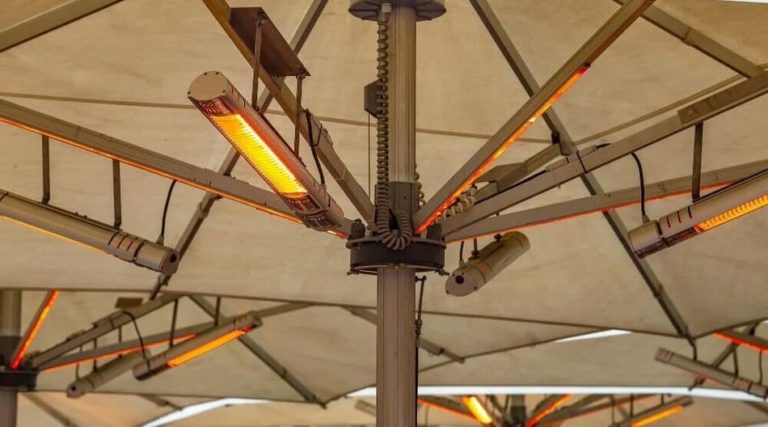What Is the Standard Stair Tread Thickness?
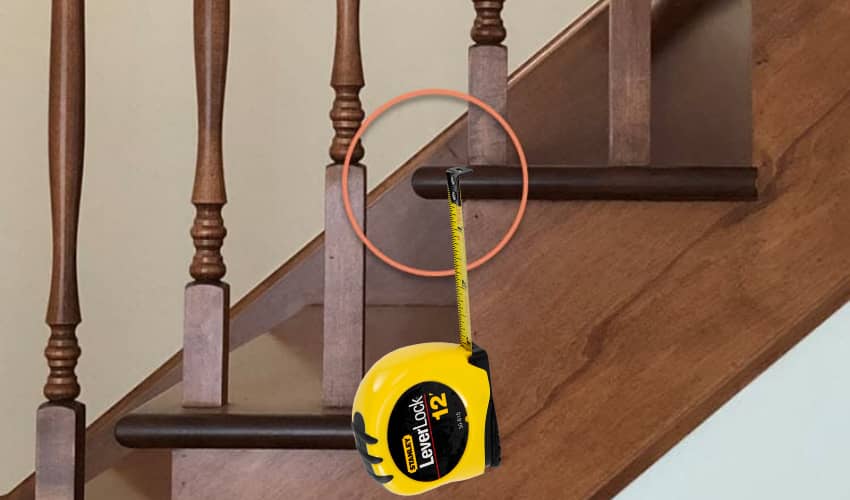
One of the main problems people face when installing new stair treads is the mismatch between the current dimensions of their stairs and the stair treads. To be more specific, the problem arises with stair tread thickness, because there are simply too many different sizes. That begs the question – what is the standard thickness of a stair tread? In this article, we’ll explain and talk about that. So, let’s start!
Table of Contents
What Is the Standard Stair Tread Thickness?
So What Is the Standard Stair Tread Thickness? Typically, the standard stair tread thickness is between 1” to 1/16”. There is no standard thickness when it comes to stairs that don’t come with a riser, which is in the range from ⅜” to 2”. Stair treads that come without risers are in most cases thicker than treads that have risers.
When talking about risers, standard rises thickness is something that cannot be discussed since it simply doesn’t exist due to various materials which are used to produce raisers and their varying strength from one material to the other. One of the most common materials used in stair raiser production is oak.
Also, if you want to learn more about stairs, be sure to read Should You Install Stair Treads or Risers First?
In this article, we will discuss the standard tread thickness and the reasons why it exists in the first place, and the difference in stair tread thickness depending on whether your stairs have a riser. We’ll also cover another very important detail when it comes to stair tread thickness: the material of the stair tread.
Important Things About Standard Thickness of a Stair Tread
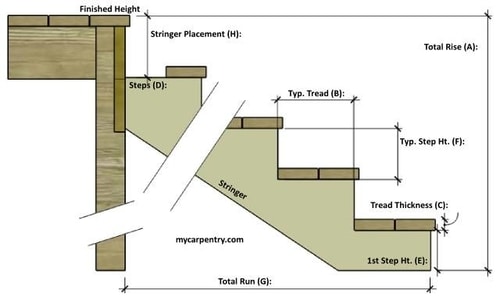
The most common stair tread thickness is 1”, although it can range from 1” to 1/16 of an inch. Keep in mind that the minimum width of a stair is 24”, while the minimum depth is 10”.
Another important detail is tread nosing, which is in some states required by law. The radius of your nosing must be ½”, which means that the thickness of your tread should be 1”, because tread thickness depends on nosing requirements. In this case, two times the nosing radius will give you the required thickness of the tread. Despite this, you can find ¾” thick treads in many stores.
A trick that tread manufacturers use is the production of treads that have a thicker nosing than the tread itself, and it also covers a part of the riser. This kind of technology allows them to fulfill the nosing requirements while producing treads that aren’t as thick. Another way to adhere to the thickness code is to add plywood or a similar material underneath the thread.
The production of threads with a thicker nosing that overlaps the riser beneath is the reason why you can find ¾” thick treads in many stores. The only requirement for this kind of setup is to have plywood or some other similar material beneath the tread to fulfill the thickness requirements.
Something to think about when you are thinking about the thickness of your stair tread is also if your stairs have a riser or not. The standard thickness is for stairs that come with risers. And when it comes to stairs that do not have risers, the minimum thickness is usually 1 ½ “, which is slightly more than the standard minimum tread thickness for stairs with risers.
In this case, the maximum thickness of your stair tread, in this case, depends on the rise/run range of your stairs, which means that if the rise/run ratio of your stairs is 7.5/11, then the thickness of your tread is bound to be less than 7.5. Otherwise, your riser-less stairs will become stairs with a riser.
In this case, the material used to produce the stair tread does not make a difference, whichever material you use, the thickness of your riser-less stair tread should be 1 ½. “
Related Article: What Is The Standard Window Height From The Floor?
Is There Stair Tread Thickness Building Code?
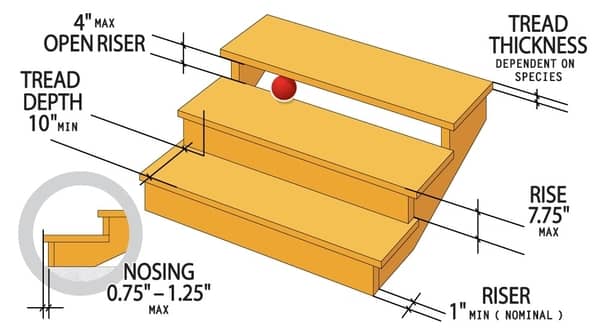
Unfortunately, there is no minimum stair tread thickness when it comes to stairs with a riser. This is because stair treads tend to be layered. Another reason is the strength of different materials that are used – treads that are produced from certain materials need to be thicker to hold weight, which varies from material to material efficiently.
But be sure to keep in mind that the maximum nosing radius is 9/16“. Why is this important? As we’ve previously mentioned, tread thickness has to adhere to nosing requirements. This means that there is a maximum tread thickness for stairs with nosing, and it is 1 1/8”. This is the number you get when you double the nosing radius.
There is a way to bypass this law, but it requires stairs with a depth of at least 11”, since they don’t require nosing, which means that you are able to choose your own tread thickness.
Unlike stairs with riser, riser-less stairs do not have a maximum thickness, while the minimum thickness should be 1 ½”, as we’ve already mentioned. Standard dimensional lumber is usually used to produce riser-less stairs, and it fulfills the minimum thickness code. The final thing to mention when it comes to nosing is how much it can extend over the riser, which is 1 ¼ “. On the other hand, it has to extend at least ¾” beyond the riser.
What Is the Best Option To Use For Stair Treads?
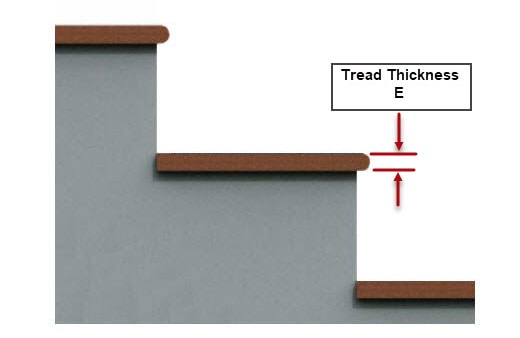
The choice of wood for your stair treads is entirely up to you. Some of the more standard choices are oak or softwoods e.g., pine.
Keep in mind that if you want to transport heavy appliances or décor elements such as a piano, softwood isn’t the best option for you. If you want durability and strength, oak is definitely the way to go. But if you are keen on using softwood, be sure to use enough stringers to reinforce the treads.
If your main worry is the appearance of your stairs, then you should go for ash or hickory. These materials are more expensive, but they will certainly give your living space a more impressive look. A cheaper option is to use plywood and cover it with vinyl or even carpet. All of these materials are extremely durable, but plywood is the cheapest by far.
Plywood Thickness For Stair Treads
Even though you might not notice it, most people use plywood when it comes to choosing their stair tread material. As we’ve already mentioned, it is cheap, and you can easily modify it by using vinyl, carpet, or any similar type of flooring.
Keep in mind that the end grain of the plywood is visible, so you don’t have to cover it with any type of material. But this kind of finish requires a nosing, and it is not the most aesthetically pleasing.
The only problem when it comes to using plywood is that it also has to achieve the required thickness as any other material. This might prove to be more expensive since you either have to use much thicker plywood or two or more pieces of standard plywood stacked on top of one another. Since carpets and vinyl are used purely for aesthetic purposes, their thickness isn’t part of the equation due to the lack of load-bearing capability.
Having all this in mind, the best option is to use plywood underneath another type of material such as ash to achieve the minimum tread thickness. This technique saves money and material and enables you to buy treads made from more expensive materials since you need less of the material.
Stair Tread Thickness for Wood Alternatives
Another example where you can also use plywood is if you decide to use laminate flooring because the maximum thickness of the laminate is only ½”, which is less than the minimum that is required for stair tread thickness. The good news is that most laminate manufacturers also produce nosing, making your job a little easier if you decide to use laminate flooring.
You may also opt for engineered or traditional hardwood flooring, but keep in mind that you will need nails to install this type of material. And even though engineered or traditional hardwood flooring are much thicker than laminate, you will still need plywood underneath these materials due to the use of nails.
Floating Stair Tread Thickness
These types of stairs are usually installed in walls or around a center column, and they have no connection to one another. Keep in mind that the minimum stair tread thickness for floating stairs is 1 ½”, but, due to the fact that floating stairs do not have risers, the maximum tread thickness can be up to 4” in some cases.
How Do I Make Stair Treads Thicker?
Be extremely careful when you want to make your stair tread thicker, because if you use another material and just place it on top of your stair tread to thicken it, you may need to enlarge your risers too. This could end up being more expensive than redoing the whole staircase. Another option is to replace the thin treads and use thicker treads this time.
If you want to improve the aesthetic side of your living space, switching up your stair tread can be a great idea if it is done properly. Be careful when replacing your stair treads since it might result in you rebuilding your whole staircase.
Upgrading your stair treads and adding more than ¼” could even become dangerous due to walkability issues, so the best way to replace your stair treads is to choose a stronger and more durable material such as oak or even plywood, while still retaining the old tread thickness.
FAQ: People Also Ask
What is a good thickness for stair treads?
If you ask a professional the best riser thickness is about ¾”, but the minimum required thickness is ½”. Nosing is also a must if you decide on having a closed riser staircase.
What is the standard size of stair treads?
You can easily find out what stair tread lengths suit you best by measuring from the front to the back of the step, but the standard length of stair treads is usually from 8 to 10 inches, depending on how large the staircase is. The length you will usually encounter is around 9 inches.
Final Thoughts
If you want to ensure your own safety, be sure to follow all the requirements when it comes to stair tread thickness and staircases in general. Even though it seems like additional and unnecessary work, it prevents possible injuries from tripping or falling.
Before you begin building your own staircase, be sure to go through a planning phase during which you should determine which type of tread and riser you want to work with. Whichever type you choose, it is important to decide on the thickness of your stair tread before you calculate the total rise of the stair.
Be sure to leave your comments and questions in the comment section below. Hopefully, this article was helpful, and thank you for reading it. Good luck with you staircase or any other project you have in mind!







